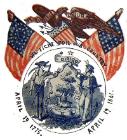



Maine attic recovery
Mod 1817 Common Rifle and the Hall Breech Loading Mod. 1819
CONFEDERATE CONVERSIONS TO PERCUSSION


MOSES D BATES – MISSOURI GRAYS
A native of Hannibal, Missouri (Founded by his father Moses Bates in 1819 and destined to become best known as the home town of author Mark Twain and as the setting of his Adventures of Tom Sawyer and Adventures of Huckleberry Finn ) Moses D. Bates Jr. enlisted on June 16, 1861 and was mustered in as a Corporal of Co. K, 4th Missouri Infantry. He was wounded and taken prisoner at Corinth, Mississippi on October 3, 1862. Paroled (date unknown) Corp. Bates returned to Co. M of his 4th Missouri regiment and was captured yet again at Vicksburg, Mississippi. As his earlier Co. K of the 4th Missouri was designated as the ‘Missouri Grays’ it is safe to assume his Common Rifle was lost when he was wounded and captured at Corinth. How Corp. Bates’s rifle came to Maine has been lost in time.







